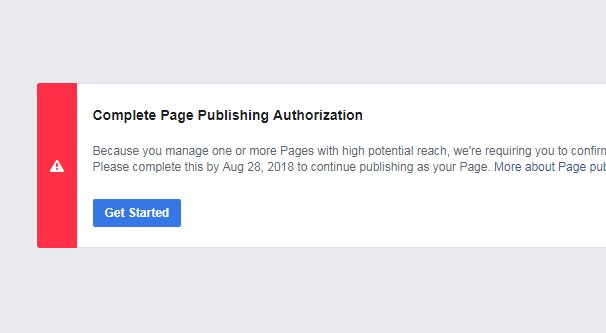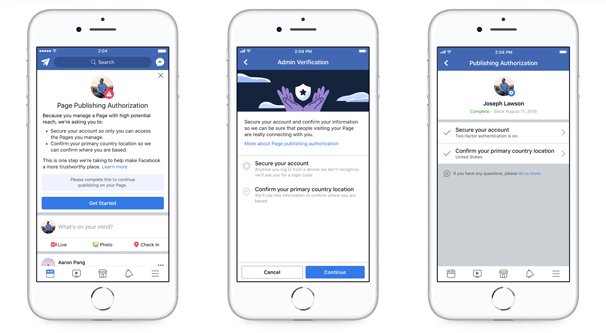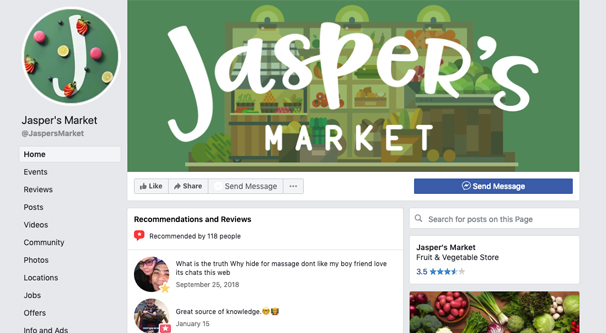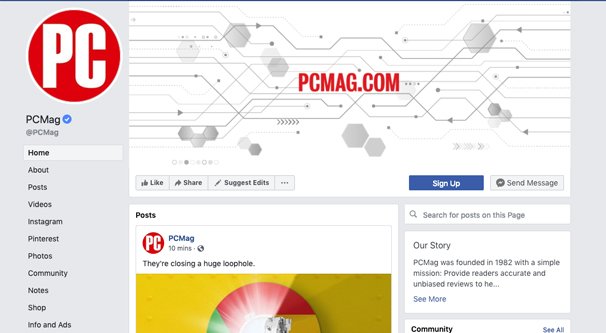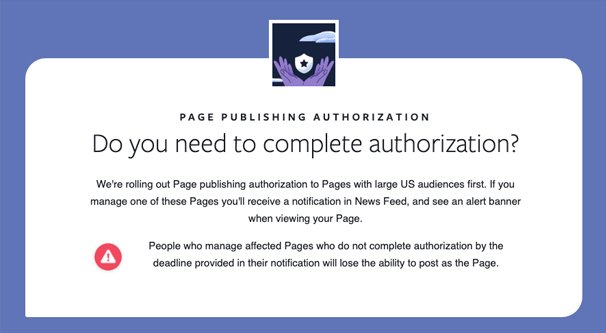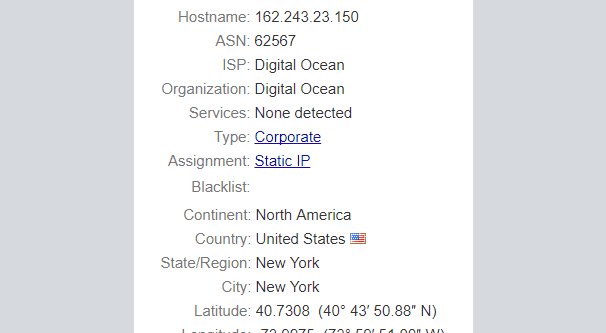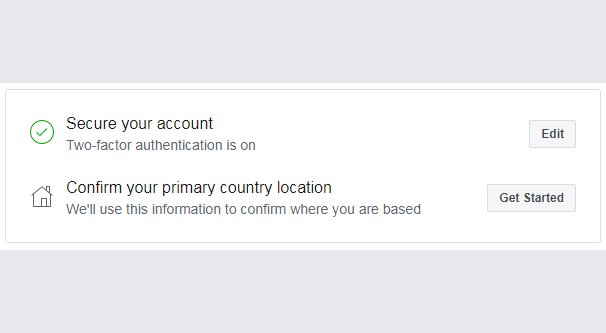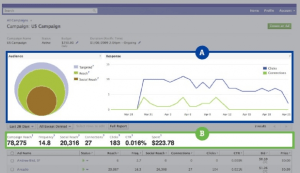 Written by ContentPowered.com
Written by ContentPowered.com
Facebook has been in the news quite a bit over the last few years, skating from one scandal to another with nary a repercussion in sight. Between the privacy violations, the information compromises, and the Russian fraud, there’s a lot to unpack.
Facebook is, at least, finally doing something about some of those issues. Particularly, they are putting the kibosh on running some kinds of fraudulent Facebook pages. They announced some of these plans back in April of 2018, and only finally started rolling them out in December. Now, in 2019, things are starting to kick off.
Introducing Page Publishing Authorization
Page publishing authorization is a security measure Facebook is rolling out on a limited basis, in the hopes that it increases trust in pages. I say limited, because there’s a lot going on behind the scenes and only a little bit of it actually impacts public perception or functionality.
The goal for publishing authorization is to increase transparency in pages. The goal is, put in plain terms, to let users know they can trust the owner of a page. It’s a measure aimed primarily at ousting pages owned by Russian troll farms spreading misinformation, while promoting pages that are owned domestically.
Page publishing authorization ONLY affects pages that have a “large US audience.” How large? They don’t say. It affects both existing pages and new pages, once those new pages reach a certain undisclosed size. It doesn’t matter where YOU are when you’re running the page, though; it only matters that a significant portion of your audience is based in the United States.
This is a measure meant to make it harder for non-US residents to operate US-based pages, clearly aimed at propaganda farms operated out of Russia. It will also catch pages that are operated from other countries, of course, including times when you have moved to another country or when you’re outsourcing your page operations.
How Does It Work?
Owners of pages that are targeted by this move will be asked to authorize themselves. It’s a form of two-factor authentication using, typically, a mobile device. You will be asked to confirm your primary country location, which I believe uses your mobile device’s GPS to confirm where you are. Otherwise, of course, you could just lie about it, right? The authorization notification looks something like this:
If you have someone other than the owner of the page authorized to manage it as an editor, moderator, or other page role, they will be presented with a banner informing them that they need to be authorized as well.
What are the penalties for not authorizing yourself or whoever runs your page for you? Well, that person is no longer able to post on the page. That’s basically it; if a page is run by a Russian troll and that person can’t authorize themselves – because they’re in Russia – they won’t be able to post on that page, effectively shutting it down.
Conceptually, this is a much easier way to filter through pages, since there are hundreds of millions of pages on Facebook. Make the good ones step up and verify themselves rather than try to filter out the bad ones.
On the other hand, this has the potential issue of collateral damage. There are a lot of Facebook-based businesses that sell the service of social media page management. There are thousands upon thousands of freelancers who do the same thing. Many of them are likely based in locations like India, Malaysia, or the Philippines, which might have issues with verification.
Display of Information
Here’s the thing: you’re not necessarily blocked from posting because you’re outside of the USA. Think of it more like disclosure than a ban.
Look at Jasper’s Market, Facebook’s Potemkin page they use for testing new features and as an example. In the left-hand sidebar, down at the bottom, you see a section called Info and Ads. Click on that.
This page is relatively new and initially served as a disclosure of the ads a given page is running. You can choose a geographic location and see the ads that a page is running in that location. If no ads are running anywhere, the page will display “there are no ads to show.”
One thing you’ll note is that Jasper’s Market has a whopping 77 authorized people managing the page. Given that it’s an internal Facebook page, I imagine a bunch of different departments have different people authorized to work on it to test their features, but I’m not a Facebook employee, I can’t say for certain.
What I can tell you is that of those 77 users, 69 of them are in the United States and one is in the United Kingdom. Two more are in India, and five of them are not disclosed.
What I don’t know is whether or not those five undisclosed or not available people are still able to post on the page or not. I suspect not. The two people in India are likely able to post, though; it’s not a filter, again, it’s disclosure. You know that there are X number of people running the page, and that two of them are in India.
Take PC Magazine as another example. They have 41 authorized users, with 34 of them in the United States, five in the UK, one in Australia and one in Canada. This is a reasonable distribution considering it’s a US-based magazine with significant readership in the other three listed regions.
As Facebook says on their page announcing all of this, and I quote: “Our goal is to prevent organizations and individuals from creating accounts that mislead people about who they are or what they’re doing.”
Some other information can appear in the Info and Ads panel as well. You can see when a page has been merged with another page or had a name changed, for example. All those meme pages that are built up to be sold to brands? Now you can see the name change in action.
Why This System Isn’t Great
So here’s the thing: Facebook is making an effort here, but their effort seems rather poorly thought out to me. I can spot at least five major problems with this new system, and none of them actually help with the issues they’re trying to address; namely, widespread disinformation campaigns meant to influence public opinion.
First of all, this measure only targets “pages with a large US audience.” That’s incredibly vague and unhelpful. Looking around, I see pages with over 20,000 followers sharing what is obviously fake news – you know, obvious Photoshops presented as real, that kind of obvious fakes – that are both actively posting and have no verified locations for any page operators. 20,000 people might not seem like much on a site with billions of users, but it’s still enough to give that page some clout in public opinion.
So what’s going on there? Is 20,000 not enough to count? I doubt it, because I see pages with under 5,000 followers that DO have their verified locations for page owners. I really doubt many of these small pages have page managers that on the ball with proactively verifying themselves.
Could it be that a majority of those 20,000 followers are not based in the US? That would exclude the page from Facebook’s filter, and yet, the page is aimed squarely at US conservatives to push them to more extreme fringes. It seems exactly the kind of page that should be targeted, but it slips through.
Another problem is that Facebook doesn’t actually take any action here. Sure, if you don’t verify your location you aren’t able to post, but if you do verify, you’re good to go. There don’t seem to be any actual geographic filters; it’s not like a Russian page manager suddenly can’t manage their page even if they verify.
Basically, it’s putting the onus of judgment on the user. We as Facebook users have to check the management of a page, which means we have to be skeptical of the page in the first place, which many of the people who trust these pages won’t be. The user has to be skeptical, we have to check management, management has to be verified, and there has to be a mismatch between what the ownership claims to be and what they are. Even then, there’s no action taken, no penalty to be seen.
You also have to consider the fact that it’s really not hard to spoof a geographic location. VPNs and proxies can show a location as being somewhere else, it’s easy to spoof a phone number, and really there’s nothing to prevent someone from faking their location through this verification, as long as they know how it works ahead of time.
On top of that, there’s absolutely no reason why disinformation trolls can’t just pay someone to manage their page in the right location. If you can pay a company in India to manage your American page, why couldn’t a Russian pay an American agent to run their fake news page? I guarantee you that many of the pages showing US-based locations are just people on the payroll of a foreign agent.
Even if they aren’t, well, this measure doesn’t do anything to stop domestic users from spreading fake news either. None of this would matter if not for hundreds of millions of gullible people who refuse to check their facts or verify their sources, or who would rather trust something reaffirming their opinions rather than seek the truth. It’s not even just political; you have to consider things like MLMs, anti-vaccine movements, and climate denial as well. Authentication does absolutely nothing to fight these problems.
And, of course, since this is Facebook, it’s US-centric. This authentication only catches pages with a significant US-based audience. Is the USA the only country being affected by fake news? Absolutely not. There’s evidence to suggest that Brexit was influenced by Russian just as much as the US election. Facebook doesn’t care about pages with a large British audience, and this authentication won’t even catch them.
Plus, if you think for a moment that the USA isn’t embarking on their own information warfare in other geographic locations, you’re overlooking another major global problem. Facebook is ascribing trust to US users of their platform regardless of what they’re doing.
How to Handle Page Authorization
In any case, it’s really simple to handle this authorization from a business standpoint, regardless of all of the issues inherent in the system. As a business, all you really need to know are the answers to two questions: will this affect my business? How can I deal with it if it does?
Will this affect your business? I have no idea. Facebook is, as mentioned, very closed-lipped about what counts as a sufficiently large audience. Just watch your page and see if the banner appears asking for authentication.
If you’re affected by this new system, it’s really quite easy to handle. Turn on two-factor authentication if you don’t already have it enabled. I generally recommend that every page owner turns this on anyway, since it’s a security feature as much as it is verification of identity. You will then need to enable location services in your Facebook app. It’s under settings in the location section. Just turn it on and Facebook will use your GPS to verify where you are.
The only issue here is if you’re paying someone else to manage your Facebook page. You will need to work through the authentication process with them, and you will have their location as a manager on your page. Depending on how this makes your business look, you may need to consider changing who manages your page. Or not! After all, people have to check to even see the information.
